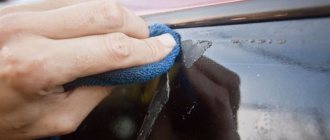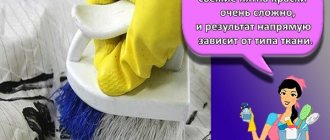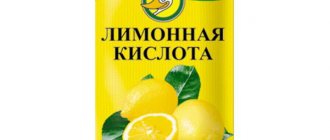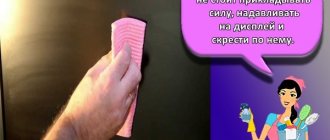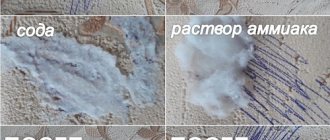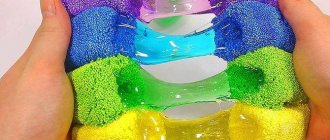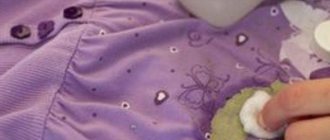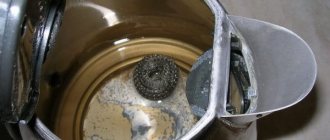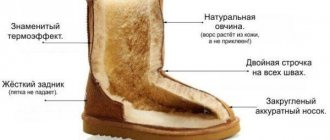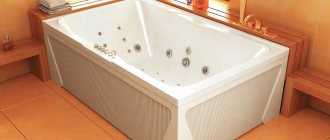Main nuances
There are many ways to remove adhesive residue from surfaces. But not all materials withstand abrasive components well. Therefore, it is necessary to conduct preliminary stain testing:
- Determine the degree of oldness of the contamination and the coating material. The choice of drug and the method of its use depend on this.
- Apply the selected product to a small fragment in an inconspicuous place. Leave it for 5 minutes. Then check the condition of the coating.
- Study the list of possible mistakes when removing stains so as not to spoil the surface.
During work it is not recommended:
- scrape the coating with sharp objects;
- remove traces of adhesive tape without prior preparation or softening;
- use toxic substances;
- neglect protective equipment.
It is necessary to choose a product for removing adhesive traces only in accordance with the coating material. For example, acetone or alcohol should not be used on substrates coated with paint or varnish. Untreated wood should not be cleaned with vegetable or essential oils. It is best to choose proven, reliable methods. These include:
- vegetable oil;
- stationery eraser;
- hair dryer;
- white spirit, gasoline, alcohol;
- liquid soap;
- baking soda;
- special industrial products.
If it is difficult to choose what to use to remove the glue from the tape , you can reuse a new strip of tape. Stick onto the fragment and sharply tear it off the surface. Fresh traces are removed immediately.
Industrial solvents for removing tape marks
Some industrial solvents are also capable of removing either fresh or old tape stains without any problems. Among the list of all existing mixtures, the following work especially well:
- "White Spirit";
- solvent;
- pre-purified gasoline for refilling lighters;
- acetone;
- ordinary kerosene.
Degreasers
Step No. 1 – preparation for cleansing
So, the first stage will be preparation. In our opinion, it should consist of two stages.
1. Find yourself protective ammunition, which should consist of:
- thick clothes with long sleeves;
- a respiratory mask through which you will breathe while you work;
- If possible, also prepare safety glasses so that the visual apparatus is also protected from harmful fumes.
We suggest you familiarize yourself with how to wash tiles in the bathroom and on the floor without streaks to make them shine: remedies, folk methods, tips. How to clean bathroom tiles after renovation: products, tips.
2. The second stage is, in fact, the purchase of the necessary materials. In our case, they will be one of the industrial solvents listed in this section, as well as:
- dry woven napkin;
- cleaning wet wipe.
First, go to the store and buy a solvent from the list presented above, any that suits your price and is available from sellers
At the same stage, it is necessary to open the window so that toxic volatile substances evaporate better and do not harm your health. And at the same time, lay it in the place where you are treating traces of adhesive tape with toxic agents, so that drops flying onto the floor are not absorbed and do not spoil the flooring, while at the same time continuing to evaporate and poison your body.
At the same step, you must open the window, and only then you can start working
Step #2 – Start Cleaning
Take a dry cloth (after putting on all the protective gear) and soak it in the industrial solvent of your choice. From our point of view, it is White Spirit that works the fastest, and it is also easier to get, however, other means work no less effectively.
Start wiping away any traces of tape with a dampened napkin. You can first moisten the marks with the product and let them sit for a while, dissolving, and then start scrubbing them off. Even if specific contaminants have been in this place for many years and have absorbed all kinds of dirt, believe me, these products will remove them.
Apply solvent to the napkin, saturate it generously, and then begin to wipe off the surface contaminated with adhesive from the tape.
Step No. 3 - wash off the remaining product with soapy water
After cleansing, the cleaned area must also be treated with soapy water and wiped clean, since the remnants of the toxic industrial solvent, if not removed, will continue to evaporate from it and poison your body.
When finished, wash the cleaned surface with soapy water and a cloth.
The human body is a fragile biological robot that can become ill when toxic substances enter its structures. In addition, working with such substances can already be dangerous for many different reasons. That is why we would like to discuss with you the main rules that must be strictly followed when interacting with industrial solvents.
When working with solvent, be sure to wear a mask, safety glasses and tight, closed clothing.
So, you don’t have to buy special clothes; you can just wear a long-sleeve shirt and long-legged pants. In principle, this will be enough, although it is also desirable that the neck be closed.
As for accessories, it is imperative to wear a mask to prevent toxic fumes from entering the respiratory tract, as well as glasses so that the fumes do not irritate the mucous membrane of the eye and cause serious damage to your vision.
The second rule is this: you cannot do such work near fire. Of course, all these substances are highly flammable, they ignite quickly and are very difficult to extinguish. Fire will spread extremely quickly in contact with them, and can potentially cause irreparable harm to you, your family members and real estate. To prevent this from happening, it is necessary to work with toxic fumes only away from potential sources of ignition.
The solvent ignites easily, to prevent a fire, work with it in a room where there are no sources of ignition
The third rule is that you can only work with the substances we described above in the open air, or, if this is not possible, with open windows. Thus, the room will be ventilated more intensively, and all harmful substances will evaporate without having time to settle or permeate objects, and also “climb” into your respiratory system.
Work with solvents only near an open window or outside the living space, if possible.
Fourth rule. When working with these substances, make sure that no one else is in the room. It is best to lock it from the inside with a key to prevent accidental entry into the premises:
- your family members;
- pets.
Pay special attention to the fact that these fumes are the most dangerous for animals and children.
The fifth rule implies mandatory cleaning of the surface treated with these substances with soapy water and a dry cloth so that they do not settle on the surfaces and do not harm your health.
We suggest you read: How to remove the smell of gasoline from your hands
Nail polish remover is a transparent liquid, usually tinted in blue, pink or greenish shades, which has both a pleasant (thanks to the perfume composition) and a pungent (thanks to acetone) odor. It is due to this that the varnish is dissolved and removed from the surfaces of our nail plates.
Nail polish remover is a tool that can also help us remove annoying traces of tape
As you might have already guessed, nail polish remover should also work if you need to remove traces of tape. Let's consider the technique of its application.
Step No. 1 – getting ready for work
So, in order to work with nail polish remover, we do not need to prepare as seriously as when working with industrial solvents, since this liquid contains only a fraction of acetone, that is, it is less concentrated, and therefore dangerous. Therefore, before working with it, we only need to prepare:
- rubber gloves (not necessary, but why stain your skin with a toxic substance once again, we’re not removing nail polish);
- mask (to avoid inhaling rapidly evaporating compounds);
- the nail polish remover itself (more);
- cotton pads;
- clean napkins.
At the same stage, we open the windows and expel animals, children and adults whose faces are not protected by masks from the room.
Be sure to also prepare a face mask to prevent inhalation of the tape remover.
Step #2 – Soak tape stains in liquid remover
As we already wrote above, nail polish remover is a much less concentrated liquid than pure acetone. By the way, only this active substance can overcome the remnants of adhesive tape; the rest of the liquid’s composition cannot do this, therefore, so that we do not have to exert an excessive amount of effort, we need to soak the contaminated area in the product.
Soaking is done like this:
- Our product is applied to a cotton pad (or pads);
- discs stick to contaminated surfaces;
- wait two to three hours, during which the fleeces are re-wetted with liquid.
Soak the surface contaminated with glue in nail polish remover
Step No. 3 - erase the remaining adhesive from the tape
So, thoroughly soaked adhesive from tape will be quite easy to remove with a new disc dipped in nail polish remover. Wipe the entire surface thoroughly, and then you can moisten another disc with water and wipe off the remaining acetone.
The cleaned surface is wiped with a damp cloth.
Another gentle remedy. Best of all, which is logical, it will clean windows and other glass surfaces from traces left by the tape, however, it will also do a great job on other hard objects. Don't write it off until you try it.
Of course, this product is gentle and will not cope with every contamination, however, it is necessary to have it in your arsenal. Of course, it is better to work with it with gloves, but in principle you will not need any additional protection to interact with it.
Window cleaner is a gentle substance that perfectly removes stains from adhesive tape from the surface of windows and other glass products.
Window cleaner
Non-aggressive removal of not too thick and old adhesive from adhesive tape can be provided by household cleaning products.
1. Dishwashing gel, diluted in high concentration in hot water and heavily foamed, will help remove this contamination from various surfaces. The resulting foam must be applied liberally to the glue and allowed to fall off several times, reapplying, and preferably more than once. The soaked glue is removed with a napkin or scraped off with a knife.
Dish soap can also help you remove the tape.
2. If you make a paste by mixing baking soda and water, you will also be able to get rid of disgusting tape stains. True, you need to apply the slurry generously, and let it soak, eat away the tape, and only then remove it with a napkin, and finally clean the surface with clean water.
Use regular baking soda
On furniture
Method No. 1 – Regular eraser
A regular eraser can help even with a very old glue stain. The only caveat is that it is suitable for removing small fragments. The eraser removes marks well from plastic or glass surfaces.
The stain is erased in the same way as on paper. After finishing the work, you need to remove the crumbs and wipe the area of former contamination with a damp cloth.
Ethyl or ammonia
It is recommended to apply ethyl alcohol to a cotton-gauze swab or cotton pad. Then you need to scrub the area until all the dirt is gone. An important condition in this case is the timely replacement of dirty swabs with clean ones, since the speed of the cleaning process depends on this. Ethyl alcohol affects the adhesive tape base at the molecular level, destroying its structure.
In addition to ethyl alcohol, you can also use ammonia. It acts similarly to ethyl alcohol. The difference is a sharp, unique smell that dissipates fairly quickly.
According to experts, fresh marks left after removing double-sided tape are easier to remove than old stains. The older the stain, the more it is absorbed into the underlying material, and accordingly, the more difficult it will be to remove it without leaving a residue. In addition, adhering dust and other small particles significantly complicate the cleaning process and restoring the original condition of the affected area. For old marks, heating procedures are well suited if the characteristics of the material on which the tape was fixed allow this.
Method No. 2 – Natural oils
The second popular option is vegetable oil. Flaxseed, olive, any essential oil, olive oil, sunflower oil work well. When the adhesive is mixed with the food product, the structure of the first component changes. For larger volumes, the oil can be poured directly onto the stain or applied with a sponge (cloth). Leave for 3 hours. After soaking the adhesive mass, remove all residues with a regular napkin and treat the surface with soapy water or dishwashing liquid. Wipe the top with a dry cloth. The method is excellent for removing glue from the surface of polished furniture. On untreated wood, the oil will be absorbed and leave a greasy stain. The difficulty in performing the procedure lies in cleaning vertical surfaces. It is difficult to fix the soaked fabric on them, and it is simply impossible to pour oil.
The product should not be used on materials that are difficult to remove oil from.
How and with what to remove traces of tape on furniture
To wipe off sticky, stubborn stains on furniture, physical effort is required. Any mechanical impact can damage the facades of the set. Effective, gentle cleaning methods must be used. Household chemical stores sell special preparations for washing off labels. They are available in the form of stick pencils or aerosols. At home, folk remedies tested by many housewives will help you wipe off traces of adhesive tape on furniture. It should be taken into account that each type of coating has its own limitations and recommendations.
From wooden surface (polished)
The varnish layer of polished furniture is extremely susceptible to the action of aggressive chemicals (acetone and other solvents); if you remove the adhesive from the tape from the varnish, you can leave cracks and scratches on the delicate surface. The following methods will help you remove dirty sticky stains from polishing:
- An ordinary office eraser. A soft rubber block carefully removes the remains of adhesive tape; it cannot scratch the varnished facades of furniture.
- Vegetable oil. You can use any that you can find in your household: sunflower, olive, burdock, castor or essential. Apply the product to the stain and leave for 15–25 minutes. The fat will dissolve the adhesive, after which the dirt can be wiped off in a circular motion and polished until glossy with a soft flannel cloth.
- Kerosene (gasoline for lighters) has a cleansing effect. Soak a piece of cotton cloth in the liquid, treat the problem area, and then wipe with a damp cloth. Contact of kerosene with furniture polishing should be short-term, otherwise cloudiness may form on the varnish surface. It is best to first test such a cleaner on an inconspicuous part of the headset.
- Unpolished wood furniture can be removed from tape residue using toothpaste and shaving foam. The product is applied to the stain, left for 20–30 minutes to soften and gently wiped with a damp cloth.
From plastic surface
Plastic furniture is washed from adhesive traces with alcohol. Medical ethyl alcohol or ammonia from your first aid kit will help remove stains from tape. The latter is perfect for white products; ammonia effectively bleaches yellowed plastic. A nail polish remover that does not contain acetone can remove the glue.
From glass surface
Glass is a more durable material, resistant to aggressive substances, and is more difficult to scratch.
- Try to wipe fresh small prints of adhesive tape off the furniture with any store-bought window cleaner (“Mr. Muscle”, “Clin”). It’s good if the product contains ammonia – it will dissolve the adhesive layer, thereby further facilitating the cleaning process.
- Acetone or white spirit (gasoline solvent). Dampen a small piece of cloth with the liquid and lightly wipe off any traces of tape. Then rinse the area with clean water and rub until shiny with a paper towel.
- Old, large sticky marks on glass furniture can be easily removed with abrasive powder cleaners. A milder option is regular baking soda. Pour the required amount of baking soda onto a damp sponge and rub the problem area. The crystals, together with the adhesive composition, will form pellets that settle on the surface of the sponge; the foam sponge will have to be rinsed frequently in clean water. Cleaning powder for dishes is more effective - “Pemoxol”, “Pemolux”, “Comet”.
It is best to test the resistance of surfaces to cleaning - apply a cleaning agent to a hidden, inconspicuous area of furniture, lightly rub the stain, make sure that the product does not leave marks or change the structure of the coating.
Method No. 5 - Solvents
Organic based industrial solvents. These also include gasoline, white spirit, and degreasers. These substances are considered aggressive, but this is the best solution for removing adhesive residues from metal, glass, and household appliances. For other coatings it is better to choose a different method.
After using the solvent, a light fragment may appear on them or the gloss may disappear. If there is no other way, then first you need to check the effect of the drug on an invisible area of the surface. The algorithm of action is to apply the composition to the place of contamination, leave for 5-10 minutes, check the degree of softness of the glue. Remove with a napkin and rinse the area with clean water.
When working with flammable substances, you must comply with all safety requirements and do not use them to clean toys.
Furniture cleaning products
Household cleaning chemicals are available in the form of sticker pencils, aerosols and liquids. The former are useful for removing dirt from small surfaces. They do not have an unpleasant odor. Sprays are universal.
They are easy to apply, work quickly and can smell pleasant thanks to fragrance additives
Liquids require more care when applying as they are more concentrated. They are also harder to apply to stains
If finances allow, you can buy household chemicals. The most popular drugs for removing contaminants are:
- Duty Scotch. A universal product that will also help clean the cabinet of dirt left by adhesive tape. It is a preparation based on several solvents at once. It is sprayed onto the surface or applied with a sponge, and after 5 minutes it is removed with a dry cloth.
- Glutoclean Pufas. Easily and quickly dissolves the adhesive base of adhesive tape. Leave for just a couple of minutes and remove the residue with a napkin.
- Scotch tape cleaner from Berner. A convenient aerosol that will remove dirt in 5 minutes. Has a pleasant citrus aroma.
- Grass “Antigraffiti”. Composition based on organic solvents and terpene oils. Spray onto the stain and leave for 1-10 minutes depending on the contamination.
- Antistick. Spray cleaner. Exposure time – 3-5 minutes.
Any substance must first be tested in a small area. The solvents included are usually strong. Therefore, they can damage furniture.
You can wipe off adhesive tape from different types of furniture surfaces using the following available means:
- Sunflower or olive oil
- Essential oil
- Petrol
- Ammonia
- Vinegar
- Nail polish remover (acetone)
- Various detergents
- Stationery eraser
- Scotch
- Cloth (microfiber)
- Ordinary hair dryer
It’s worth noting in advance: each of these tools is not universal.
They should be used carefully to clean furniture with different surfaces to avoid damage to the coating.
A window cleaner or a paste of laundry soap and hot water (in a 3:1 ratio) will help remove traces of tape on a window or coffee table.
Acetone (acetone-containing liquid), purified gasoline, medical alcohol or vodka are suitable for glass and mirror surfaces that are not tinted.
Solvents are the best option for glass
Citric acid can also cope with glue: dissolve ½ teaspoon of crystalline powder in a glass of warm water, apply the mixture to the stain for 15-20 minutes, then remove any remaining glue with a dry cloth.
Method No. 6 – Home hair dryer
The device helps to remove adhesive from tape that has been on the surface for a long time. It is also good to remove traces of double-sided tape using a hairdryer. Its action is based on a thermal reaction.
The adhesive mass softens, this makes it possible to remove residues with any detergent or cleaning agent. The disadvantage of this method is that it cannot be used on surfaces sensitive to elevated temperatures. As a result, the attractive appearance is lost and the decorative properties of objects are reduced.
Removing remaining tape with a drill
A drill can remove the tape marks for you. Put a rubber nozzle on it and use it to treat a contaminated surface with old dirt, however, try to make the revolutions at medium intensity so as not to damage the surface.
This can be done on almost any hard surface, but it is better not to touch household appliances or other electronics, as vibration from the drill may damage them.
A special attachment on the drill will help you effectively remove remaining tape.
How to remove tape marks from plastic
Plastic is probably the most common material in our homes. It is used to make furniture, dishes, household items, toys for children, etc. Before trying to clean traces of adhesive tape from plastic elements, it is necessary to evaluate the quality of the plastic. For good plastic, more aggressive means are suitable.
So, to remove old tape that has left marks, you will need:
- gasoline or white spirit;
- pencil eraser;
- vegetable oil;
- hair dryer.
So, let's start with vegetable oil. It makes it easy to remove traces of tape. After all, after mixing with its glue, the oil can change its properties. The oil must be poured directly onto the surface. If it's vertical. Then you need to wet a rag with it and apply it to the surface for a couple of hours. After losing its stickiness, the mass is simply wiped off with a napkin. The plastic is then washed with soap. This method cannot be used if subsequently it is not possible to thoroughly wash the object from oil.
A regular eraser also makes it possible to remove traces of tape from furniture, glass and other objects. Moreover, he is able to cope with even the oldest traces. All dirt can be removed using the principle of pencil marks on a sheet of paper. After this, you just need to blow away or sweep away the debris. The “disadvantage” of this method is that it is very labor intensive. After all, if there is a need to clean a significant area covered with film, it will take a lot of effort and time.
Purified gasoline intended for refilling conventional lighters or white spirit can quickly and effectively wash off the effects of sticking tape from any plastic object. The surface is wiped with cotton wool or a small rag moistened with the indicated solutions. Next, the item must be washed using any detergent.
The “disadvantage” of this method is the aggressiveness of the means used. As a result, it is quite possible to remove the top layer of plastic along with the remaining tape. As a result, the item may become dull or lighter spots may appear. Therefore, before cleaning, it is better to try the product on the hidden part of the plastic object. And, of course, such cleaning methods are not suitable for toys.
As you know, tape that has been on the surface for a long time eats into it. As a result, the plastic object and the tape become one. This especially applies to films used to cover the frames of plastic windows, as well as information stickers on glass. In the case of windows exposed to the sun and the vicissitudes of the weather, the tape is almost impossible to clean. In this situation, a regular hair dryer can help.
Under the influence of heat, the glue can soften, as a result of which it will succumb to the influence of various types of cleaning agents. A hairdryer will also help when removing a kind of double-sided tape. After all, in addition to glue, the latter also contains foam materials and rubber, which are capable of firmly sticking to the surface. The “disadvantage” of the described technique is that not every type of plastic can survive heating with a hairdryer without losing its aesthetic appeal. Also, a hairdryer is not always available.
